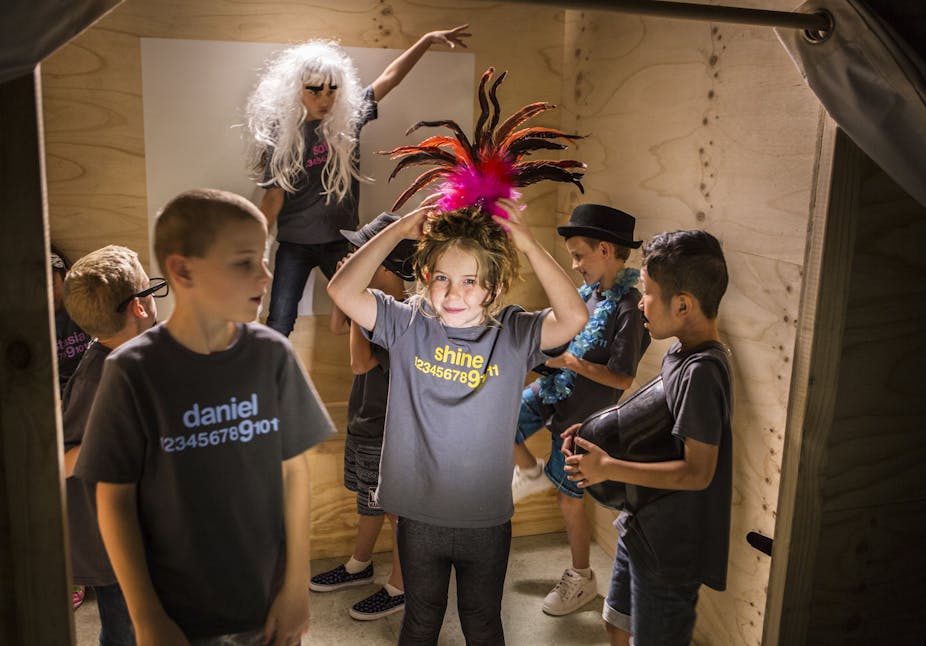The modern creativity era was born in the early days of the US-Soviet space race. When the Soviet Union launched the first artificial satellite, Sputnik I, its plaintive beeps, accessible to anyone with a radio, did more than demonstrate the technological possibilities of rockets and satellites. The so-called Sputnik Shock of October 1957 started a new conversation about creativity that’s still underway today.
This week, the documentary Life at 9 screened on ABC1 and picked up on some of the key questions about creativity and children. Are kids as creative as they used to be – and how do we measure their creativity as they grow and develop?
How did the Russians get to space?

Sputnik kicked off a wave of introspection in the West as politicians, scientists, engineers and educators sought to explain the Soviet victory in the first lap of the space race.
One immediate conclusion was that similar achievements could only be made by highly skilled people. The US Congress quickly passed the National Defence Education Act in 1958 to address a shortage of graduates in mathematics and engineering.
However, at the same time, experts began to hypothesise that the problem was not merely a shortage of engineers. It was also suggested that part of the problem lay in the fact that Soviet engineers must be inherently more creative.
Guilford’s ideas
The links between creativity, education and technology had already been explored by the American psychologist J. P. Guilford.
In his presidential address to the American Psychological Association (APA) in 1950, Guilford had argued that human intellectual ability had been defined too narrowly in terms of factors such as speed, accuracy and correctness – parameters that he characterised as convergent thinking. It needed to be described in a broader sense. Guilford saw intellectual ability as encompassing both convergent, or analytical, thinking and thinking characterised by the ability to generate alternatives and see multiple possibilities – in other words, divergent thinking.
Perhaps not surprisingly, creativity research found a home in educational psychology. Investigators explored the intellectual and educational ramifications of divergent thinking. What personal, psychological factors link to the ability to generate ideas? How do we recognise creativity when it occurs? What cognitive processes help and support the ability to think divergently? What cultural and environmental factors help or hinder idea generation?
Of no less importance to creativity research was the question of how to measure it. In particular, how do we measure creative potential in individuals?
Creative tests
This question was addressed, most famously, by Paul Torrance, who first developed the Torrance Tests of Creative Thinking in the mid-1960s. For nearly 50 years therefore, researchers and educators have had access to a reliable and valid instrument by which to judge and compare creativity across a wide range of age groups.
The popularity of the Torrance Tests – a combination of verbal and figural (drawing) tests that assess fluency, flexibility, originality and elaboration – means that a considerable body of data now exists by which longitudinal trends in creative potential can be examined.
Indeed, this is exactly what US researcher Kyung Hee Kim set out to do in her 2011 study, The Creativity Crisis.
This study drew on test results from more than 270,000 participants. The most interesting – indeed alarming – finding is that since 1990, and even as IQ scores in the same period have risen, scores on the Torrance Tests have shown a significant decrease. This decrease has been most noticeable among younger children, with a particular “4th Grade Slump” evident.
Life at 9 and the creativity crisis
This was the driving force behind this week’s episode of Life at 9. The program is part of the Life Series and follows a group of children as they grow and develop.
The producers took the opportunity, given the ages of the children, to examine their creativity. They weren’t necessarily looking for evidence of the hypothesised slump – but rather for the opportunity to show that, slump or not, creativity is not a fixed, unchanging trait, but something that is open to change and development.
The latest episode of Life at 9 also highlighted the fact that, at this age, creativity may be less affected by school-related factors and more influenced by domestic factors.
For this reason parents, as much as school teachers, need simple guidelines for understanding what creativity is and how it is fostered.
Good habits
The eminent America psychologist and creativity researcher Robert J. Sternberg conceived of creativity as a habit. Like any habit, it is fostered through a combination of:
- opportunity (to engage in it)
- encouragement (when those opportunities are taken)
- rewards (when creative thinking and behaviour is demonstrated).
Sternberg further described 12 keys to developing the habit of creativity, all of which inform both how children could be taught so as to foster creativity and how parents can work to develop their children’s creativity. This includes encouraging sensible risk-taking and encouraging a tolerance of uncertainty or ambiguity.
If we succeed, the pay-off is far more than test scores and statistics. The ability to correctly identify and define problems, question and analyse assumptions, generate ideas, surmount obstacles and take risks is fundamental to our ability to cope with change.
Change brings a constant stream of new problems, and we thrive on the strength of our ability to find creative solutions to these problems, whether we are nine or 99 years old.
Life at 9 screened on ABC1 and can be viewed on ABC iview. Details here.

